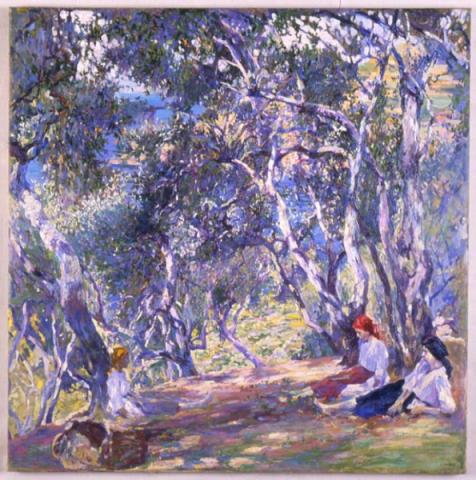Artwork of the month - May 2022
May 2022
Antonio Discovolo
(Bologna 1874 - Bonassola 1956)
Riposo, 1916
Oil on canvas, cm 89,5x92
inv. AM 1

In the painting Riposo Antonio Discovolo represents an interesting country scene, in which three country women are enjoying a moment of quiet from their work, surrounded by the trees. An inscription on the back suggests that this is a view of Bonassola and probably of the olive grove that surrounded the painter's house in the Ligurian town where he had been living since 1910: "a house [...] facing the sea, so that it might be like an open heart for my mother, my companion, my children, my true friends; that it might be a solitary place created for the religion of my work and the serenity of my spirit. Fortune gave me a home among olive trees. The olive tree is a symbol of peace. I am happy.
The use of the Divisionist style, which Discovolo - after his academic training in Florence and his apprenticeship with Giovanni Fattori - experimented with during his time in Rome (1899-1905), also with the help of his friend and colleague Enrico Lionne, allows for suggestive atmospheric and luminous effects, due to the skilful alternation of pure colours and lively chromatic contrasts, translated into a brushstroke that is sometimes dotty and sometimes filamentous. In this painting, in particular, one can appreciate the deliberate use of complementary colours, with the juxtaposition of yellows with lilacs and purples, resulting in an effect of brilliant luminosity. The theme of work itself appears subordinate to the transcription of the beauty of nature.
A leading figure in the Roman Secession, in whose exhibitions he was an active participant throughout the 1910s, Discovolo experimented with different styles throughout his artistic career, abandoning Divisionism and moving on in the 1920s to a more solid and dense brushstroke, without ever abandoning a close eye on reality and a predilection for landscapes, always marked by a certain sentimentality.
The painting was exhibited at the 4th International Exhibition of the Roman Secession in 1916-1917 together with another work, Hay Bearers. On that occasion, Rest was considered to be of particular value by the Commission for Municipal Purchases of Works of Art at the Roman Exhibitions and thus, by municipal resolution, included in the municipal collections.
Return to the section > The Galleria d'Arte Moderna artwork of the month







































